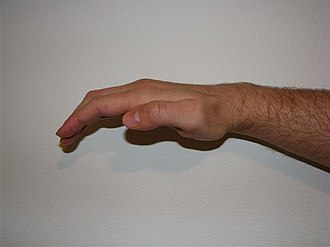Median nerve palsy

Editor-In-Chief: Prab R Tumpati, MD
Obesity, Sleep & Internal medicine
Founder, WikiMD Wellnesspedia &
W8MD medical weight loss NYC and sleep center NYC
| Median nerve palsy | |
|---|---|
 | |
| Synonyms | Median neuropathy |
| Pronounce | N/A |
| Specialty | Neurology, Orthopedic surgery |
| Symptoms | Weakness in the hand, numbness in the thumb, index, and middle fingers |
| Complications | Carpal tunnel syndrome, thenar atrophy |
| Onset | Can be sudden or gradual |
| Duration | Varies, can be chronic |
| Types | N/A |
| Causes | Trauma, compression, inflammation |
| Risks | Repetitive strain injury, diabetes mellitus, rheumatoid arthritis |
| Diagnosis | Physical examination, nerve conduction study, electromyography |
| Differential diagnosis | Ulnar nerve palsy, radial nerve palsy, cervical radiculopathy |
| Prevention | N/A |
| Treatment | Splinting, physical therapy, surgery |
| Medication | NSAIDs, corticosteroids |
| Prognosis | Varies, depends on cause and treatment |
| Frequency | Common |
| Deaths | N/A |


Median nerve palsy is a condition that affects the median nerve, leading to a loss of function or sensation in the hand. It is often caused by injury or pressure on the nerve.
Causes[edit]
The median nerve can be damaged by a variety of causes, including trauma, repetitive strain injury, carpal tunnel syndrome, and diabetes. The nerve can also be compressed by a tumor or cyst, or by swelling due to inflammation or infection.
Symptoms[edit]
The symptoms of median nerve palsy can vary depending on the severity and location of the nerve damage. They may include:
- Numbness or tingling in the hand or fingers
- Pain in the hand or wrist
- Weakness in the hand or fingers
- Difficulty with fine motor skills, such as buttoning a shirt or writing
- Loss of coordination in the hand
Diagnosis[edit]
Diagnosis of median nerve palsy typically involves a physical examination and a review of the patient's medical history. The doctor may also order tests such as electromyography (EMG) or nerve conduction studies to confirm the diagnosis and determine the extent of the nerve damage.
Treatment[edit]
Treatment for median nerve palsy depends on the cause and severity of the nerve damage. It may include:
- Physical therapy to improve strength and flexibility in the hand
- Occupational therapy to help the patient adapt to the loss of function in the hand
- Pain management techniques, such as medication or nerve blocks
- Surgery to repair the damaged nerve or relieve pressure on the nerve
Prognosis[edit]
The prognosis for median nerve palsy depends on the cause and severity of the nerve damage. With appropriate treatment, many patients can regain some or all of the lost function in their hand.
Ad. Transform your life with W8MD's Budget GLP-1 injections from $75


W8MD offers a medical weight loss program to lose weight in Philadelphia. Our physician-supervised medical weight loss provides:
- Weight loss injections in NYC (generic and brand names):
- Zepbound / Mounjaro, Wegovy / Ozempic, Saxenda
- Most insurances accepted or discounted self-pay rates. We will obtain insurance prior authorizations if needed.
- Generic GLP1 weight loss injections from $75 for the starting dose.
- Also offer prescription weight loss medications including Phentermine, Qsymia, Diethylpropion, Contrave etc.
NYC weight loss doctor appointmentsNYC weight loss doctor appointments
Start your NYC weight loss journey today at our NYC medical weight loss and Philadelphia medical weight loss clinics.
- Call 718-946-5500 to lose weight in NYC or for medical weight loss in Philadelphia 215-676-2334.
- Tags:NYC medical weight loss, Philadelphia lose weight Zepbound NYC, Budget GLP1 weight loss injections, Wegovy Philadelphia, Wegovy NYC, Philadelphia medical weight loss, Brookly weight loss and Wegovy NYC
|
WikiMD's Wellness Encyclopedia |
| Let Food Be Thy Medicine Medicine Thy Food - Hippocrates |
Medical Disclaimer: WikiMD is not a substitute for professional medical advice. The information on WikiMD is provided as an information resource only, may be incorrect, outdated or misleading, and is not to be used or relied on for any diagnostic or treatment purposes. Please consult your health care provider before making any healthcare decisions or for guidance about a specific medical condition. WikiMD expressly disclaims responsibility, and shall have no liability, for any damages, loss, injury, or liability whatsoever suffered as a result of your reliance on the information contained in this site. By visiting this site you agree to the foregoing terms and conditions, which may from time to time be changed or supplemented by WikiMD. If you do not agree to the foregoing terms and conditions, you should not enter or use this site. See full disclaimer.
Credits:Most images are courtesy of Wikimedia commons, and templates, categories Wikipedia, licensed under CC BY SA or similar.
Translate this page: - East Asian
中文,
日本,
한국어,
South Asian
हिन्दी,
தமிழ்,
తెలుగు,
Urdu,
ಕನ್ನಡ,
Southeast Asian
Indonesian,
Vietnamese,
Thai,
မြန်မာဘာသာ,
বাংলা
European
español,
Deutsch,
français,
Greek,
português do Brasil,
polski,
română,
русский,
Nederlands,
norsk,
svenska,
suomi,
Italian
Middle Eastern & African
عربى,
Turkish,
Persian,
Hebrew,
Afrikaans,
isiZulu,
Kiswahili,
Other
Bulgarian,
Hungarian,
Czech,
Swedish,
മലയാളം,
मराठी,
ਪੰਜਾਬੀ,
ગુજરાતી,
Portuguese,
Ukrainian


